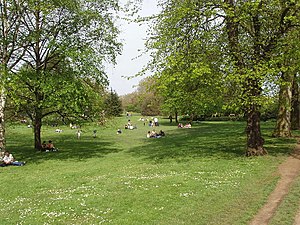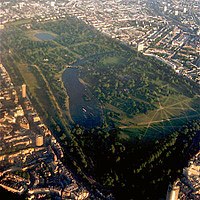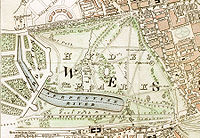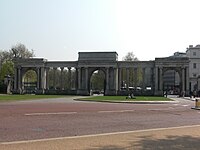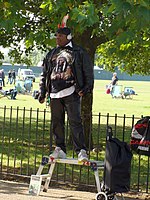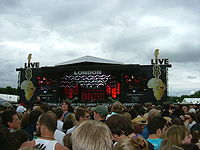Hyde Park
Hyde Park is a large Royal Park in Middlesex, and is one of the largest parks of London, extending over 350 acres. It is famous for its history and for several features and places within it, including Speakers' Corner.
The park was the site of the Great Exhibition of 1851, for which the Crystal Palace was designed by Joseph Paxton. The park has become a traditional location for mass demonstrations. The Chartists, the Reform League, the Suffragettes and the Stop The War Coalition have all held protests in the park. Many protesters on the Liberty and Livelihood March in 2002 started their march from Hyde Park. On 20 July 1982 in the Hyde Park and Regents Park bombings, two bombs linked to the Provisional Irish Republican Army caused the death of eight members of the Household Cavalry and the Royal Green Jackets and seven horses.
The park is divided in two by the Serpentine. The park is contiguous with Kensington Gardens; although often still assumed to be part of Hyde Park, Kensington Gardens has been technically separate since 1728, when Queen Caroline made a division between the two. Hyde Park covers 350 acres[1] and Kensington Gardens covers 270 acres,[2] giving an overall area of 630 acres, making the combined area larger than the Principality of Monaco (480 acres). To the southeast, outside the park, is Hyde Park Corner. Although, during daylight, the two parks merge seamlessly into each other, Kensington Gardens closes at dusk but Hyde Park remains open throughout the year from 5 am until midnight.
Hyde Park is the largest of four parks which form a chain from the entrance of Kensington Palace through Kensington Gardens and Hyde Park, by way of Hyde Park Corner and Green Park (47 acres), past the main entrance to Buckingham Palace and then on through Saint James's Park (57 acres) to Horse Guards Parade in Whitehall.
History
In 1536, King Henry VIII acquired the manor of Hyde from the canons of Westminster Abbey, who had held it since before the Norman Conquest;[3]
The Oxford Book of British Place Names says the various "Hyde" place-names, including Hyde Park, comes from the Anglo-Saxon unit of land taxation, the hide.
Hyde Park was enclosed as a deer park and remained a private hunting ground until James I permitted limited access to gentlefolk, appointing a ranger to take charge. Charles I created the Ring (north of the present Serpentine boathouses), and in 1637 he opened the park to the general public.
In 1689, when William III moved his habitation to Kensington Palace on the far side of Hyde Park, he had a drive laid out across its south edge, formerly known as "The King's Private Road", which still exists as a wide straight gravelled carriage track leading west from Hyde Park Corner across the south boundary of Hyde Park towards Kensington Palace. The drive is now known as Rotten Row, possibly a corruption of rotteran (to muster),[4] Ratten Row (roundabout way), Route du roi or rotten (the soft material with which the road is covered).[5] Public transport entering London from the west paralleled the King's private road along Kensington Gore, just outside the park. In the late 1800s, the row was used by the wealthy for horseback rides.[6]
The first coherent landscaping was undertaken by Charles Bridgeman for Queen Caroline;[7] under the supervision of Charles Withers, the Surveyor-General of Woods and Forests, who took some credit for it. It was completed in 1733 at a cost to the public purse of £20,000. Bridgeman's piece of water called The Serpentine, formed by damming the little River Westbourne that flowed through the park was not truly in the Serpentine "line of beauty" that William Hogarth described, but merely irregular on a modest curve. The 2nd Viscount Weymouth was made Ranger of Hyde Park in 1739 and shortly began digging the Serpentine lakes at Longleat.[8] The Serpentine is divided from the Long Water by a bridge designed by George Rennie (1826).
One of the most important events to take place in the park was the Great Exhibition of 1851. The Crystal Palace was constructed on the south side of the park. The public in general did not want the building to remain in the park after the closure of the exhibition, and the design architect, Joseph Paxton, raised funds and purchased it. He had it moved to Sydenham Hill in Surrey.[9]
Another significant event held in Hyde Park was the first Victoria Cross investiture, on 26 June 1857, when 62 men were decorated by Queen Victoria in the presence of Prince Albert and other members of the Royal Family, including their future son-in-law Crown Prince Frederick of Prussia, later Emperor Frederick III.[10]
Grand Entrance
The Grand Entrance to the park, also known as the Victoria Gate, at Hyde Park Corner next to Apsley House, was erected from the designs of Decimus Burton in 1824–25.[11] An early description reports:
"It consists of a screen of handsome fluted Ionic columns, with three carriage entrance archways, two foot entrances, a lodge, etc. The extent of the whole frontage is about 107 feet. The central entrance has a bold projection: the entablature is supported by four columns; and the volutes of the capitals of the outside column on each side of the gateway are formed in an angular direction, so as to exhibit two complete faces to view. The two side gateways, in their elevations, present two insulated Ionic columns, flanked by antae. All these entrances are finished by a blocking, the sides of the central one being decorated with a beautiful frieze, representing a naval and military triumphal procession. This frieze was designed by Mr Henning, junior, the son of Mr Henning who was well known for his models of the Elgin marbles. "The gates were manufactured by Messrs. Bramah. They are of iron, bronzed, and fixed or hung to the piers by rings of gun-metal. The design consists of a beautiful arrangement of the Greek honeysuckle ornament; the parts being well defined, and the raffles of the leaves brought out in a most extraordinary manner."
Sites of interest
Sites of interest in the park include Speakers' Corner (located in the northeast corner near Marble Arch), close to the former site of the Tyburn gallows, and Rotten Row, which is the northern boundary of the site of the Crystal Palace. South of the Serpentine is the Diana, Princess of Wales memorial, an oval stone ring fountain opened on 6 July 2004. To the east of the Serpentine, just beyond the dam, is London's Holocaust Memorial. Another memorial in the park commemorates the victims of 7/7 terrorist attacks of July 2005, in the form of 52 steel pillars - one for each of the dead.
A botanical curiosity is the Weeping Beech, Fagus sylvatica pendula, cherished as "the upside-down tree". Opposite Hyde Park Corner stands one of the grandest hotels in London, The Lanesborough (Formerly - until the early 1970s- St George's Hospital). Stanhope Lodge (Decimus Burton, 1824–25) at Stanhope Gate,[12] demolished to widen Park Lane, was the home of Samuel Parkes who won the Victoria Cross in the Charge of the Light Brigade. After leaving the army, Parkes became inspector of the park's constables, and died in the lodge on 14 November 1864. A rose garden, designed by Colvin & Moggridge Landscape Architects, was added in 1994.[13]
In 1867 the policing of the park was entrusted to the Metropolitan Police, the only royal park so managed, due to the potential for trouble at Speaker's Corner. A Metropolitan Police station ('AH') is situated in the middle of the park. The 1872 Parks Regulation Act created positions of "park keeper" and also provided that "Every police constable belonging to the police force of the district in which any park, garden, or possession to which this Act applies is situate shall have the powers, privileges, and immunities of a park-keeper within such park, garden, or possession."[14]
Events
Hyde Park has been the venue for some famous rock concerts, including the major location for the Live 8 string of benefit concerts. It is estimated that 150–200 thousand people turned up for the event.[15] The record concert attendance is probably for the 1969 concert by the Rolling Stones. According to much of the press, the crowd then was estimated between 250,000 and 500,000.[16] Blur played here as part of their reunion. They released a live album recorded at the park called All the People: Blur Live at Hyde Park.
Since 2008 Hyde Park has hosted "winter wonderland", a Christmas fun fair.
Since 1996, the park has been the London venue for the Proms in the Park concerts, held on the last night of the BBC Proms. July 2012 saw series of concerts with leading names.
For the 2012 Summer Olympics, the park will host the triathlon and the 10 km open water swimming events.
The park is also planning to hold the 2012 Iron Man competition. It is a temporary venue that will be built in June 2012 and taken down following the 2012 Games.[17]
References
- ↑ "Hyde Park". Royalparks.org.uk. http://www.royalparks.org.uk/parks/hyde_park/. Retrieved 11 December 2011.
- ↑ "Kensington Gardens". Royalparks.org.uk. http://www.royalparks.org.uk/parks/kensington_gardens/. Retrieved 11 December 2011.
- ↑ It was the northeast part of the manor of Eia, or Ebury. 'The Acquisition of the Estate', Survey of London 39: The Grosvenor Estate in Mayfair, Part 1 (General History) (1977), pp. 1–5; about the time of Domesday the manor of Eia was divided into three smaller manors, Ebury (Eia), Neyte and Hyde. "The latter still lives and flourishes as a royal park, under its ancient name, no doubt of Saxon origin", Edward Walford, Old and New London: Volume 4
- ↑ Edward Walford. 'Hyde Park', Old and New London: Volume 4 (1878), pp. 375–405. http://www.british-history.ac.uk/report.aspx?compid=45205. Retrieved 29 January 2009.
- ↑ E Cobham Brewer. 'Dictionary of Phrase and Fable. Henry Altemus, 1898; Bartleby.com, 2000. http://www.bartleby.com/81/14534.html. Retrieved 29 January 2009.
- ↑ Dunton, Larkin (1896). The World and Its People. Silver, Burdett. p. 30.
- ↑ Bridgeman was Royal Gardener 1728–38; he also designed the Round Pond in Kensington Gardens. Peter Willis, Charles Bridgeman and the English Landscape Garden (London and New York) 1978, devotes a chapter to Bridgeman's Royal Commissions.
- ↑ Timothy Mowl, "Rococo and Later Landscaping at Longleat" Garden History 23.1 (Summer 1995, pp. 56–66) p. 59, noting Jacob Larwood, The Story of London Parks 1881:41.
- ↑ Purbrick, Louise: "The Great Exhibition of 1851: New Interdisciplinary Essays": 2001: Manchester University Press, p. 122
- ↑ Crook, M. J.: "The Evolution of the Victoria Cross": 1975: Midas Books, pp. 49-52
- ↑ Howard Colvin, A Biographical Dictionary of British Architects 1600–1840, 3rd ed. 1995, under "Decimus Burton."
- ↑ Burton also provided lodges at Cumberland Gate and Grosvenor Gate]]. (Colvin 1995:"Decimus Burton".)
- ↑ "Hyde Park". GardenVisit.com. http://www.gardenvisit.com/landscape/london/lguide/hyde-park-landscape.htm. Retrieved 11 December 2011.
- ↑ An Act for the regulation of the Royal Parks and Gardens, 1872
- ↑ BBC documentary 7 ages of Rock [1] and Queen fan site [2]
- ↑ Bill Wyman's book "Rolling with the Stones"
- ↑ London2012.com profile. - accessed 29 September 2010.
Outside links
| ("Wikimedia Commons" has material about Hyde Park) |
